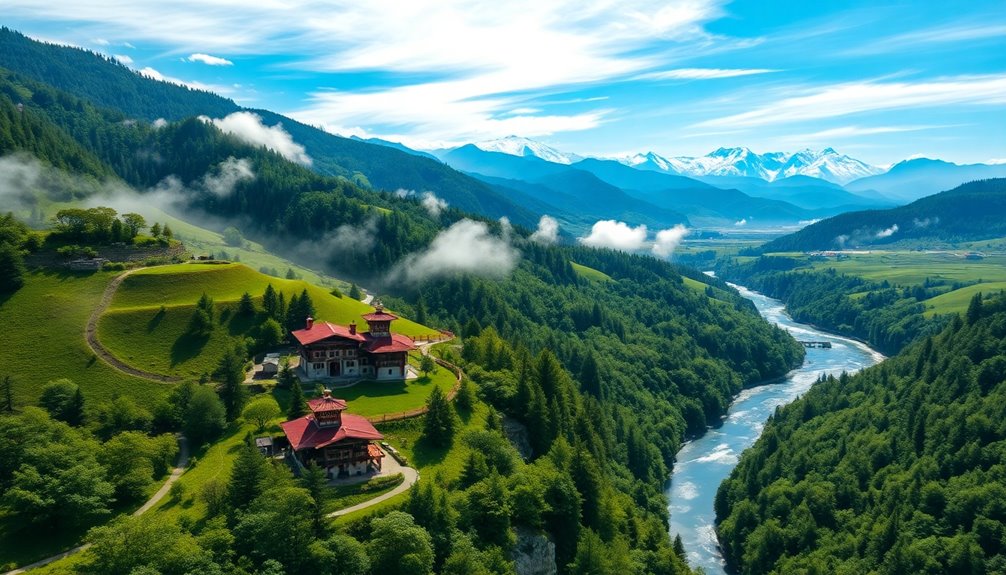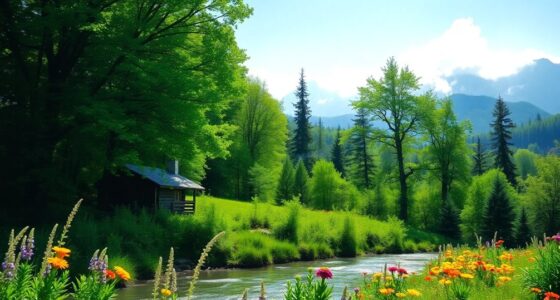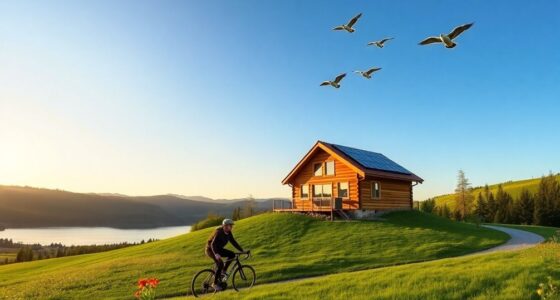If you're looking for the world's most eco-friendly destination, Green Bhutan won't disappoint. With over 71% forest cover, it's the only carbon-negative country globally. You'll find stunning biodiversity, including rare species like the Bengal tiger and red panda. Bhutan promotes sustainable travel through community-led initiatives such as tree planting and waste management programs. Plus, your Sustainable Development Fee of $65 supports local initiatives. You can immerse yourself in vibrant cultural experiences that enhance your understanding of Bhutanese traditions. Explore how simple choices can deepen your connection to this beautiful country and aid in its ongoing environmental efforts.
Key Takeaways
- Bhutan maintains over 71% forest cover and is the only carbon-negative country, emphasizing its commitment to environmental conservation.
- Strict regulations against hunting and trading endangered species protect diverse wildlife, including the Bengal tiger and red panda.
- Community-led reforestation projects and the "Clean Bhutan" initiative promote sustainable practices and engage tourists in environmental stewardship.
- Eco-tourism strategies, such as a Sustainable Development Fee, fund local conservation initiatives while limiting tourist numbers to preserve cultural authenticity.
- Bhutan encourages low-impact activities and eco-friendly accommodations, enhancing travel experiences while minimizing carbon footprints.
Introduction
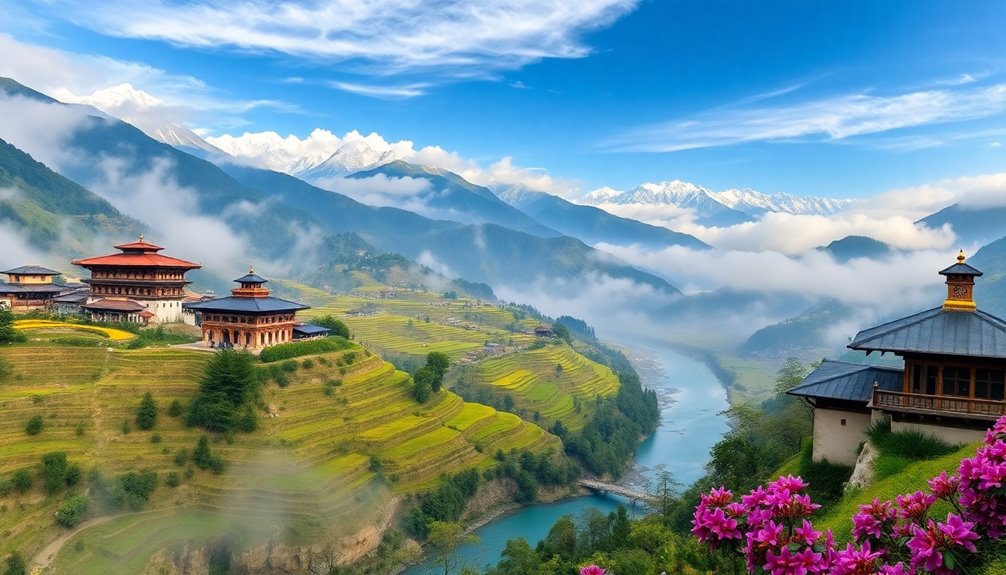
When you think of Bhutan, picture a land rich in biodiversity and steeped in culture.
This Himalayan hotspot not only protects its unique ecosystems but also embraces eco-tourism as a way to celebrate and preserve its heritage. Bhutan's commitment to biodiversity conservation ensures that its natural treasures are safeguarded for future generations.
Himalayan Biodiversity Hotspot
Bhutan stands as a remarkable example of a Himalayan biodiversity hotspot, teeming with life and ecological richness. Here, you'll encounter over 5,400 species of flowering plants, 700 bird species, and 200 mammals, including the elusive Bengal tiger and the charming red panda.
The country's diverse habitats, ranging from subtropical plains to alpine meadows, create a unique environment for many endemic and endangered species. Bhutan's commitment to conservation shines through its 71% forest cover, making it the only carbon-negative country in the world.
With numerous protected areas, such as national parks and wildlife sanctuaries, Bhutan promotes sustainable practices that ensure the preservation of critical habitats for future generations. This commitment to biodiversity is truly inspiring and essential for global ecological health.
Cultural Preservation Through Eco-Tourism
While exploring the breathtaking landscapes of Bhutan, you'll discover a country that harmonizes eco-tourism with cultural preservation.
Bhutan's unique approach ensures that your travel experience not only benefits local communities but also safeguards their rich heritage.
Here are three ways cultural preservation thrives in this eco-friendly paradise:
- Limited Tourist Numbers: By regulating visitor flow, Bhutan maintains its cultural authenticity and minimizes environmental impact.
- Support for Local Artisans: Accommodations designed by local craftsmen reflect the nation's commitment to cultural identity while boosting the economy.
- Cultural Experiences: Engaging in festivals and traditional practices allows you to immerse yourself in Bhutanese culture, supporting its continuity.
This blend of eco-tourism and cultural preservation makes Bhutan a truly unique destination.
Travel From New York City
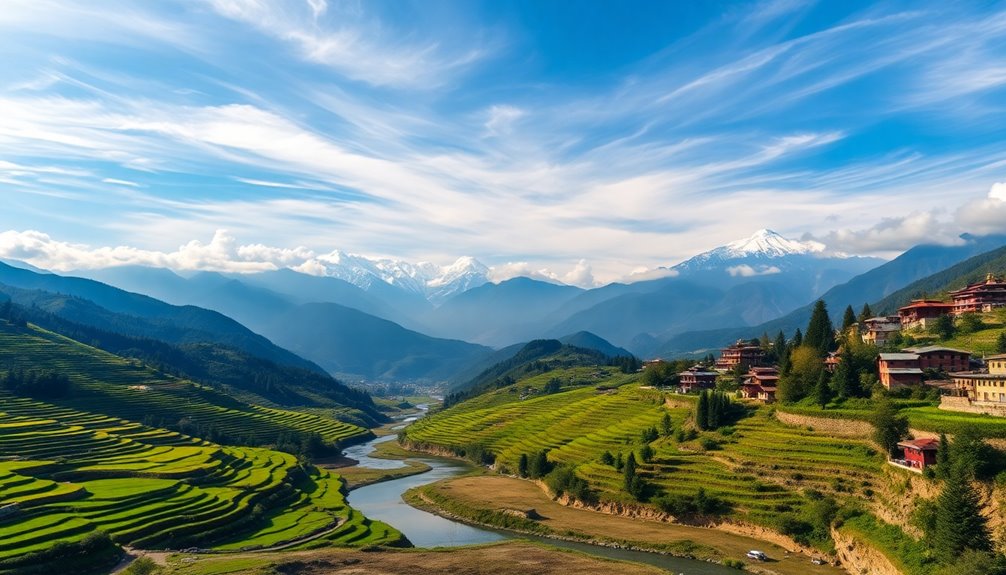
Traveling from New York City to Bhutan involves connecting flights, usually through cities like Bangkok or Delhi, before landing at Paro International Airport.
You'll need to secure a visa in advance, and your travel package will include a Sustainable Development Fee, ensuring your visit supports the country's initiatives.
Once you're there, expect a unique cultural experience, with opportunities for adventure like electric bike rentals to explore the stunning landscapes.
Travel From NYC to Bhutan
Reaching the enchanting landscapes of Bhutan from New York City requires a bit of planning and patience, as it typically involves multiple flight connections through major hubs like Delhi or Bangkok before landing in Paro, the country's only international airport.
The journey can take around 20-30 hours, depending on layovers. Here are a few key things to keep in mind:
- Visa Requirements: You'll need to book through a licensed travel agency, including a minimum daily package fee of $200 to $250.
- Sustainable Development Fee: This $65 daily fee supports education, healthcare, and infrastructure in Bhutan.
- Best Travel Seasons: Plan your visit during spring (March to May) or fall (September to November) for breathtaking views.
Travel From London to Bhutan
Flying from London to Bhutan is an adventure that requires a bit of planning, as most travelers will make layovers in cities like Delhi or Bangkok before arriving at Paro International Airport.
While some select European cities may offer direct flights depending on the season, expect your journey to take around 18 to 24 hours, including layover times.
Before you go, remember to secure your visa through a licensed tour operator, which must be arranged along with your travel itinerary.
Embrace sustainable travel by considering Bhutan's minimum daily package fee of $200 to $250, which covers accommodation, meals, and a guide.
Additionally, a daily sustainable development fee of $65 supports local education and healthcare, making your trip even more impactful.
Travel From Sydney to Bhutan
Although there's no direct flight from Sydney to Bhutan, you can easily make your way there with a connecting flight, typically through cities like Bangkok or Delhi.
Your journey will take around 20 to 30 hours, depending on layover times. Once you arrive in Bhutan, you'll need a visa, which is arranged through a licensed tour operator since independent travel isn't allowed.
Here are three tips to enhance your travel experience:
- Plan your itinerary: Focus on must-see destinations like the Tiger's Nest Monastery.
- Budget for the Daily Package Fee: Expect to pay between $200 to $250 for a comprehensive travel experience.
- Embrace local culture: Participate in vibrant festivals to immerse yourself fully in this eco-friendly travel destination.
Electric Bike Rentals Available
Once you've made your way to Bhutan, exploring the breathtaking landscapes and vibrant culture becomes a thrilling adventure.
One of the best ways to experience this is through electric bike rentals, which offer an eco-friendly transportation option. By choosing to rent an electric bike, you'll minimize your carbon footprint while enjoying the stunning valleys and serene mountain roads.
Local providers facilitate the rental process, promoting sustainable mobility and supporting Bhutan's economy. These bikes are designed for comfort and efficiency, making it easy for you to navigate the diverse terrain.
Plus, riding through this carbon-negative country aligns perfectly with Bhutan's commitment to environmental conservation and sustainable tourism.
Eco-Conscious Cultural Experiences
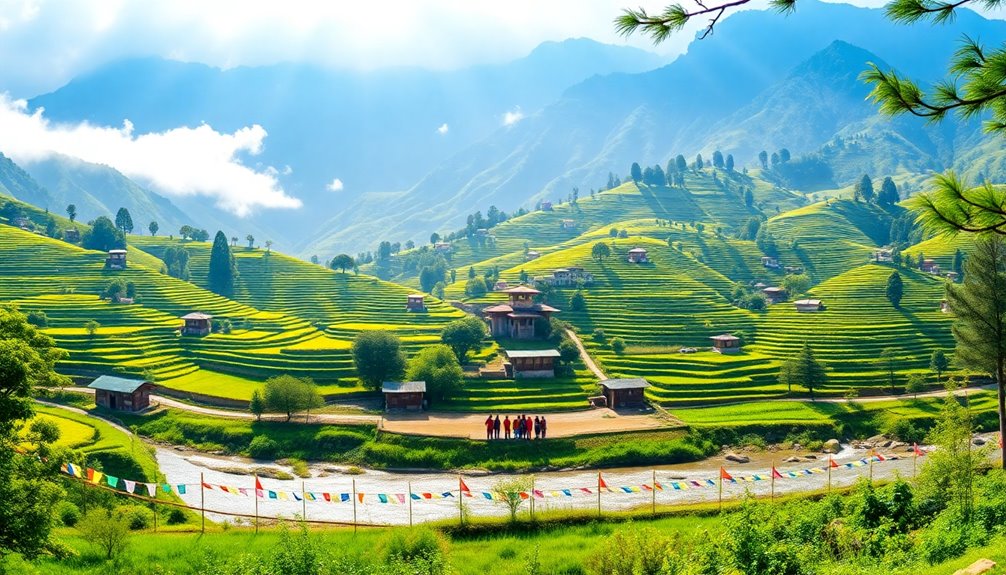
In Bhutan, you can engage in wildlife conservation volunteer programs that let you contribute to preserving the stunning local ecosystem.
You'll also find opportunities for wildlife tracking and birdwatching, connecting you with the country's rich biodiversity.
Plus, sustainable lodging options ensure your stay supports the environment while immersing you in the beauty of Bhutanese culture.
Wildlife Conservation Volunteer Programs
When you join wildlife conservation volunteer programs in Bhutan, you dive into hands-on experiences that protect the country's rich ecosystems. Engaging in these low-impact initiatives not only enhances your connection with nature but also supports local communities.
Here are three ways you can make a difference:
- Reforestation Projects: Help restore forests and promote biodiversity by planting native species.
- Wildlife Monitoring: Collaborate with local conservationists to track and protect endangered species.
- Community Education: Participate in programs that teach sustainable practices to locals, preserving Bhutan's cultural heritage.
These experiences foster a deep appreciation for Bhutan's unique environment while aligning with its Gross National Happiness philosophy, making your volunteer journey both impactful and fulfilling.
Wildlife Tracking and Birdwatching
Participating in wildlife conservation volunteer programs naturally leads you to explore the wonders of Bhutan's rich biodiversity through wildlife tracking and birdwatching. With over 770 bird species, including the endangered Black-necked Crane, every trek offers a chance to encounter unique wildlife.
| Activity | Highlights |
|---|---|
| Wildlife Tracking | Discover diverse ecosystems |
| Birdwatching Tours | Learn about rare species |
| Educational Components | Emphasize conservation efforts |
Eco-conscious trekking routes like the Snowman Trek let you observe Bhutan's pristine nature while minimizing your impact. You'll also engage with local communities, deepening your understanding of their vital role in conservation. Experience the harmony of nature and culture in this eco-friendly paradise!
Sustainable Lodging Options
Opting for sustainable lodging in Bhutan not only enhances your travel experience but also supports the local economy and culture.
You'll find a variety of eco-conscious options that embody Bhutan's commitment to sustainability:
- Locally-Owned Accommodations: Stay at places like Zhiwa Ling Heritage or charming homestays, where you'll enjoy authentic cultural experiences.
- Luxury Eco-Lodges: Experience opulence at Six Senses Bhutan or andBeyond Punakha River Lodge, focusing on local materials and wellness treatments inspired by Bhutanese traditions.
- Organic Dining: Savor authentic Bhutanese cuisine sourced from local farms, promoting sustainable agricultural practices.
These sustainable lodging options not only minimize environmental impact but also deepen your understanding of Bhutan's rich cultural and ecological values.
Respect Local Wildlife Guidelines
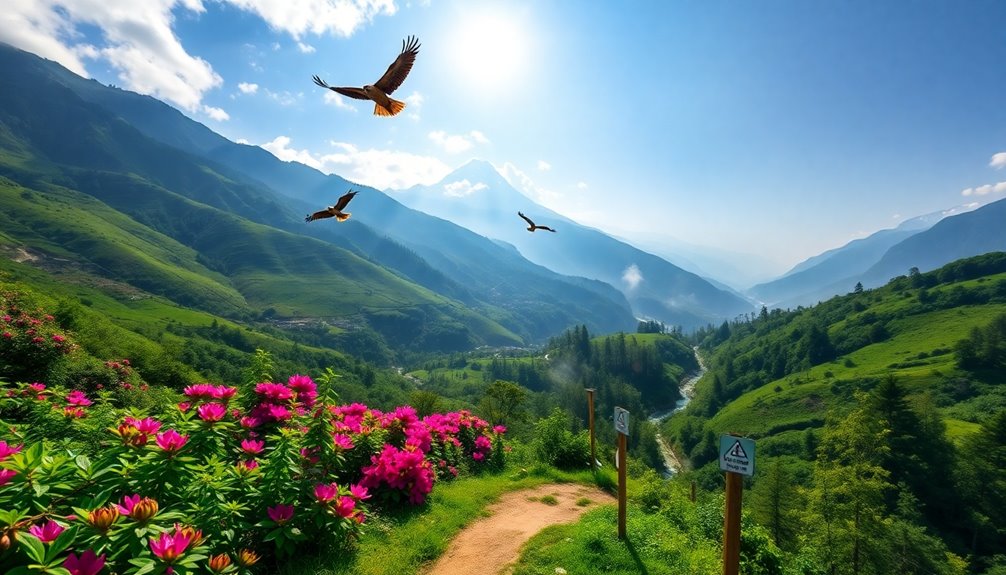
While exploring the breathtaking landscapes of Bhutan, you should always prioritize respecting local wildlife guidelines. Bhutan's constitution protects wildlife, making it one of the few carbon-negative countries.
Keep a safe distance from animals and avoid feeding them; this helps maintain their natural behaviors and habitats. By doing so, you support local communities in their efforts to conserve biodiversity.
Strict regulations against hunting and trading endangered species ensure the protection of these unique creatures.
When you participate in guided eco-tours, embrace the educational components that highlight the importance of preserving local wildlife and their ecosystems.
Engage in responsible wildlife tourism, particularly in national parks and protected areas, to minimize your impact while appreciating Bhutan's rich natural heritage.
Community-led Reforestation Projects
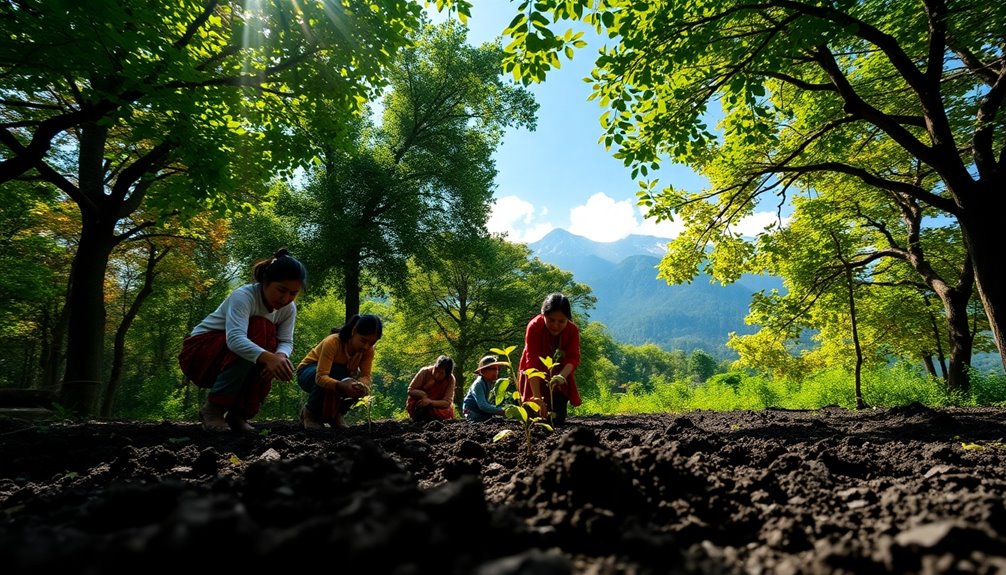
You'll see how Bhutan's government and NGOs collaborate with local communities to drive successful reforestation efforts.
These initiatives not only enhance biodiversity but also strengthen cultural ties and sustainability practices.
Government and NGO Efforts
As Bhutan continues to prioritize environmental sustainability, the government's and NGOs' commitment to community-led reforestation projects plays a crucial role in maintaining the nation's impressive forest cover.
These initiatives not only preserve the environment but also engage local communities in meaningful ways. Here are a few highlights of their efforts:
- The "1 Guest 1 Tree Planted" project invites tourists to plant trees, boosting local ecosystems.
- The "Clean Bhutan" project emphasizes waste management while promoting reforestation as a solution to littering.
- Community-based campaigns involve schools, fostering awareness and education about forest preservation.
Through these government and NGO efforts, Bhutan showcases its dedication to maintaining over 71% forest cover, a testament to its commitment to environmental conservation.
Community and Cultural Sustainability
Community-led reforestation projects in Bhutan not only enhance the environment but also strengthen cultural ties among locals. By engaging in these initiatives, you directly contribute to a greener future while fostering a deeper connection with the community.
The "1 Guest 1 Tree Planted" program allows tourists to participate in tree planting, ensuring every visit helps improve Bhutan's carbon-negative status. Local residents take charge of planning and executing these projects, which instills a sense of ownership and responsibility.
With Bhutan exceeding 71% forest coverage, the commitment to sustainability is evident. Educational programs linked to community-led reforestation projects also equip locals with the knowledge to promote biodiversity and ecological stewardship, ensuring a sustainable environment for generations to come.
Optimal Months for Eco-Tourism
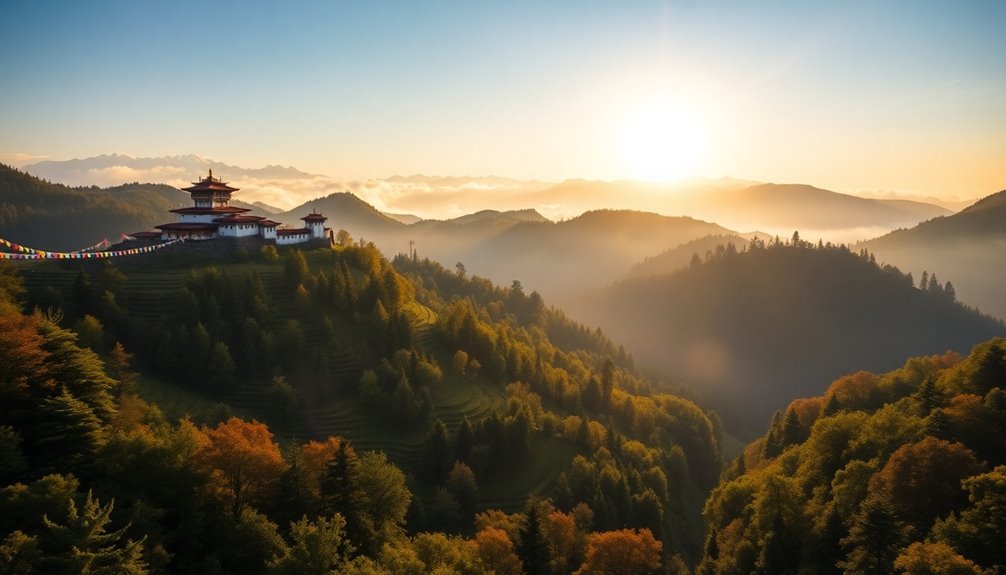
If you're planning a trip to Bhutan for eco-tourism, you'll want to consider the best months for wildlife viewing and how the monsoon season affects your experience.
March to May and September to November are ideal for exploring the rich biodiversity, while the off-peak times can offer a quieter, more intimate connection with nature.
Keep in mind that the monsoon season can bring heavy rains, so plan accordingly to make the most of your adventure.
Best Months for Wildlife Viewing
From March to May and September to November, Bhutan offers some of the best months for wildlife viewing, thanks to its mild weather and heightened animal activity.
As a carbon-negative country, Bhutan's commitment to conservation ensures rich biodiversity, making your wildlife encounters even more rewarding.
Here are three highlights to consider during these optimal months:
- Spring Splendor: Witness the blooming rhododendrons and spot the vibrant Himalayan Monal during March to May.
- Autumn Adventures: Enjoy clear skies in September to November, perfect for spotting elusive snow leopards and red pandas.
- Protected Parks: Explore national parks like Jigme Dorji, where minimal human interference enhances your wildlife experience.
Plan your trip wisely to make the most of these incredible opportunities!
Monsoon Season Travel Advice
While the optimal months for wildlife viewing in Bhutan draw many visitors, the monsoon season offers its own unique charm for eco-tourism.
From June to September, you'll find Bhutan's vibrant flora thriving, creating stunning landscapes that showcase the country's rich biodiversity. To make the most of your trip, consider visiting during the shoulder months of June and September to avoid heavy rains while still enjoying lush scenery.
Keep in mind some potential travel delays due to rain, but fewer tourists mean a more tranquil experience at popular sites. Engage in guided treks to appreciate the natural beauty and learn about sustainable practices, all while supporting Bhutan's carbon-negative status through its rich forest cover and local agriculture.
How to Make Your Trip More Sustainable
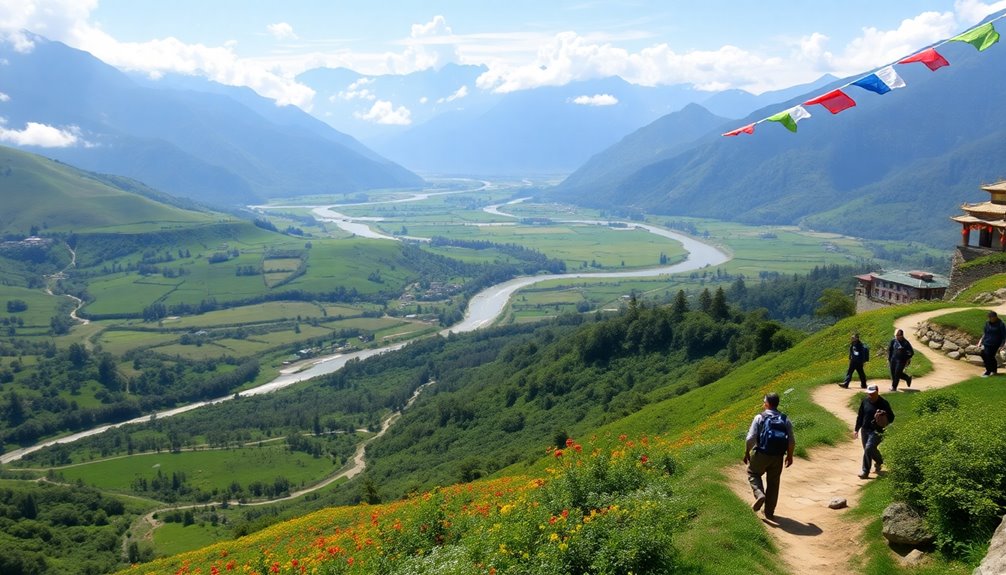
To make your trip more sustainable in Bhutan, consider bringing reusable containers for your snacks to cut down on waste.
Supporting local artisans by purchasing their crafts not only helps the economy but also gives you a unique souvenir that reflects Bhutanese culture.
These small choices can make a big impact on preserving the environment and community.
Reusable Containers for Snacks
Packing snacks in reusable containers is a simple yet impactful way to make your trip to Bhutan more sustainable. By using these containers, you help reduce single-use plastic waste, supporting Bhutan's ban on plastic bags and its commitment to being the world's only carbon-negative nation.
Here are three benefits of carrying reusable containers for snacks:
- Minimize Waste: Ditch single-use plastics and align with the Clean Bhutan project's goals.
- Enjoy Local Cuisine: Taste local foods while keeping your carbon footprint low.
- Promote Responsible Tourism: Enhance your travel experience by contributing to Bhutan's environmental conservation efforts.
Additionally, using reusable containers can also help mitigate the impact of climate change, as sustainable practices in tea production are increasingly important for preserving our planet's resources.
Incorporating reusable containers into your travel routine fosters a cleaner, more sustainable destination for all.
Support Local Artisans' Crafts
How can you make your trip to Bhutan not only memorable but also sustainable? One great way is to support local artisans. By purchasing handmade crafts, like colorful gho and kira garments, you help preserve traditional techniques and ensure that more revenue stays within local communities.
This fosters economic growth and empowers local craftspeople, aligning with Bhutan's commitment to sustainable development. Engaging in workshops or demonstrations allows you to connect authentically with Bhutanese culture and craftsmanship.
Plus, many accommodations showcase local artisans' work in their décor, promoting a sustainable tourism model. Your support not only enriches your experience but also contributes to the preservation of Bhutan's unique heritage and environmental stewardship.
Frequently Asked Questions
Is Bhutan the Most Environmentally Friendly Country?
You might argue that Bhutan stands out as one of the most environmentally friendly countries in the world.
With over 71% of its land covered in forests and a commitment to sustainability, it's taken significant steps to protect its environment.
Bhutan's ban on plastic bags and focus on eco-friendly tourism demonstrate its dedication to conservation.
While there are other contenders, Bhutan's unique policies and practices certainly set it apart as a leader in environmental efforts.
What Is the Most Eco Friendly Place on Earth?
When you think about eco-friendly places, consider locations that prioritize sustainability and conservation.
Some of the top contenders include Costa Rica, known for its biodiversity and commitment to renewable energy, and Sweden, which leads in waste management and green technology.
You might also explore Finland's sustainable forest practices or New Zealand's eco-tourism initiatives.
Each of these destinations embodies a strong dedication to preserving the environment while offering visitors unique experiences.
Why Is Bhutan so Sustainable?
You'll find Bhutan's sustainability stems from its deep-rooted commitment to environmental preservation.
The government enforces strict policies to maintain forest cover, ensuring at least 60% of land remains wooded. Bhutan prioritizes Gross National Happiness over economic growth, embedding sustainability into its national ethos.
With a focus on low-impact tourism and a ban on plastic bags, you can see how the nation balances ecological health with community well-being, creating a truly sustainable environment.
Why Is Bhutan so Clean?
Picture walking through a vibrant forest, where the air is crisp and the ground is free of litter.
Bhutan's cleanliness stems from strict regulations, like the nationwide ban on plastic bags implemented in 2019. You'll notice how this commitment fosters a culture of respect for nature.
The Clean Bhutan project tackles waste management effectively, and the nation's dedication to reforestation ensures that the environment remains pristine, making every visit an unforgettable experience.
Conclusion
In conclusion, visiting Bhutan isn't just a trip; it's a journey into a world where nature thrives and culture flourishes hand in hand. By choosing eco-friendly practices and supporting local initiatives, you're not just a tourist—you're a guardian of this green paradise. So, pack your bags and let the majestic mountains and vibrant traditions inspire you to travel sustainably. Together, let's leave footprints that nurture rather than harm this magical land!

